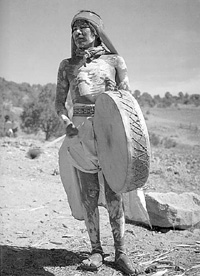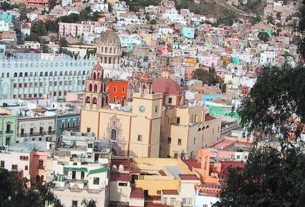Never conquered by the Aztecs and despite being defeated by Mexican armies, the Tarahumara still consider themselves an independent nation. So strong is this conviction that in the Fifties they more than once took complaints directly to the United Nations. Perhaps the purest and most unmixed of any Indian tribe in Mexico, so little is known about them that their true name “Raramuri” was corrupted to “Tarahumara” by white men and never corrected.
 Most of the world knows them only as long distance runners. Living in high altitudes, they have developed tremendous lung capacity and in more primitive times hunted deer and mountain goats, running them down on foot. In more modern times, they have run non-stop in relay teams from Chihuahua City to El Paso, a distance of 230 miles, to open the Pan-American Road Races.
Most of the world knows them only as long distance runners. Living in high altitudes, they have developed tremendous lung capacity and in more primitive times hunted deer and mountain goats, running them down on foot. In more modern times, they have run non-stop in relay teams from Chihuahua City to El Paso, a distance of 230 miles, to open the Pan-American Road Races.
However, this running ability is only one facet of their life style. The truly remarkable thing about them is an ancient religion which has bred into them a moral code so strict that they are unable to tell a lie.
Psychologists suggest that over the centuries this value system has actually caused physiological changes in their brain that preclude speaking anything but the truth. Nor can they cheat or fail to aid a fellow tribesman.
Luis G. Verplancken, a Jesuit priest who lived among them for many years and is probably the greatest authority on their history and culture, describes them as loyal to God, to their own traditions and their own culture. Although the majority of them have converted to Christianity, there are still some “gentile” groups who have refused baptism. Those converted have introduced their own ancient concepts into their new religion.
God is both Father and Mother. Respect for one another is of prime importance. They give greater value to persons than to things. In their eyes both the white man and the Mestizo are more pagan than their unbaptized fellow Raramuri because over the years these two groups have enslaved, lied, cheated and driven them off most of the fertile land they once inhabited.
Today the “People” (the translation of the name Raramuri) have been driven into the highest reaches of the Sierra Tarahumara, in the State of Chihuahua. There, even the valleys are over 5000 feet above sea level. Now, it appears their last bit of fertile land may be taken over by outsiders, forcing the Indians to retreat higher into the mountains.
Despite this, most Raramuri still ignore the blandishments of Mexican city living. They cling to native costume. The men wear a loin cloth, held together by a wool girdle wrapped twice around the waist. A long, loose, full sleeved shirt of cotton and a cloth head band complete the outfit. The women wear full multiple or layered skirts. Blouses are always worn loose at the waist. They have full sleeves, heavily pleated at the wrists and shoulders. Like the men, they wear cloth head-bands.
With some, however, western-style garb is making inroads and more and more, the colorful native dress is being worn only during festivals or in the more remote villages.
What has kept the “People” true to their ancient customs is a combination of a wilderness homeland and an inherited value system of obligation to fellow men, plus their devotion to ancient Gods they brought with them into Christianity.
In their culture, long established rituals and symbols replace things of a contemplative nature. Thus, they prefer to pray in ritual dances rather than verbal forms. Their ancient theology was not based on dogma or abstract concepts; nor is their new Christianity. Rather it is a day by day practice of living in harmony with nature and their fellow man.
Thus, they still look on the moon and stars as religious symbols. To pay homage to the Cross and Saints they sign across the face and turn their body to the left, the same way they saluted their ancient God. This sign of the cross, according to Father Verplancken, is not of Christian origin but was part of their ancient dance, “Yumari,” in which they offered food to the four points of the compass and their traditional God to insure rain and ward off evil.
Recognizing this indigenous dance-oriented method of prayer, the Jesuits introduced the “Dance of the Matachines.” It originated in the northern province of Venice in Italy, and is still performed there during Carnival. The Raramuri perform it on all the Holy Days of the Catholic church. Costumed, masked dancers move to the beat of drums and the wailing of flutes. Other dances are performed to solicit rain, heal the sick, bury the dead. All blend the new Christianity with ancient practices.
The first missionaries in the area were the Jesuits who arrived in 1607. However in 1767 King Charles III of Spain expelled them from New Spain. Although the Franciscans continued to work in the area, lack of funds and personnel made it impossible to fill the role the Jesuits had played. Also, the 19th Century Mexican Wars of Independence hampered their efforts.
It was not until the start of the 20th century that missionaries were able to return. During this almost 150 years of freedom from outside influence, what developed was a unique Raramuri Christianity.
One of the strange results of the expulsion of the Jesuits was the assumption of duties normally reserved for priests by the “Siriames,” the traditional headmen or governors. Marriages, baptisms, and other church services such as continued instruction and spiritual guidance were now in their hands.
Whether the departing Jesuits delegated these rites or whether this was simply a return to traditional roles, we do not know. Nevertheless, the old ways were so close to Christian practice that the new religion survived the absence of priests. What developed was a set of practices acceptable to both the Church and the “Peoples” life style. Thus healers, rainmakers and other keepers of the tribal heritage exist side by side with Catholic priests. Living conditions among the Raramuri today are still primitive. They continue to barter rather than use pesos, and speak little Spanish.
In 1965 the Jesuits founded a hospital in Creel, the largest city in the area. There, Father Verplancken made his home. There are two other hospitals in the area, free to all who need them. Despite this, the future of the Raramuri is bleak. Malnutrition and disease go hand in hand with the loss of fertile, food-producing land. Through all of this, the Mexican government has stood silent.
Yet, these remarkable people have maintained themselves, enduring hardships that would have sent a group with less inner strength fleeing to urban centers, abandoning their tribal culture. But the time has come for the government to intervene. Stop the land-grabbers. Permit “The People” to live in their own villages, own their land, perserve their own ways.
With the rapprochement between Mexico and the Vatican, hopefully the Church can offer more material aid, while allowing the Raramuri to pray in their own way, understanding that they worship the same Father who they preach sent his Son to bring salvation to all mankind.



I have a charcoal drawing of one of father Verplanckens photographs signed by ?
Mike
Sounds like a great find but I have no idea who the artist might be. I have never seen any charcoal drawings of his superb photographs. (Many of his color photographs were used to illustrate “The Tarahumar of Mexico, Their Environment and Material Culture” (Editorial Agata, Guadalajara, 1996). Link gives more details of the book.
The drawing is signed Jurado. It is of a young Raramuri child.
Mike
I don’t know of any “Jurado” connected to the Copper Canyon, but it’s always possible that another reader of this exchange of comments will be able to help. TB.
Thank you Tony I also found the photograph online.
Mike